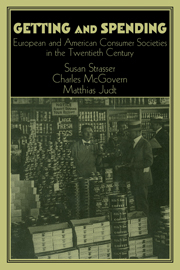Book contents
- Frontmatter
- Introduction
- Part One Politics, Markets, and the State
- Part Two Everyday Life
- 9 World War I and the Creation of Desire for Automobiles in Germany
- 10 Gender, Generation, and Consumption in the United States: Working-Class Families in the Interwar Period
- 11 Comparing Apples and Oranges: Housewives and the Politics of Consumption in Interwar Germany
- 12 “The Convenience Is Out of This World”: The Garbage Disposer and American Consumer Culture
- 13 Consumer Culture in the GDR, or How the Struggle for Antimodernity Was Lost on the Battleground of Consumer Culture
- 14 Changes in Consumption as Social Practice in West Germany During the 1950s
- 15 Reshaping Shopping Environments: The Competition Between the City of Boston and Its Suburbs
- 16 Toys, Socialization, and the Commodification of Play
- 17 The “Syndrome of the 1950s” in Switzerland: Cheap Energy, Mass Consumption, and the Environment
- 18 Reflecting on Ethnic Imagery in the Landscape of Commerce, 1945-1975
- Part Three History and Theory
- Index
10 - Gender, Generation, and Consumption in the United States: Working-Class Families in the Interwar Period
Published online by Cambridge University Press: 05 January 2013
- Frontmatter
- Introduction
- Part One Politics, Markets, and the State
- Part Two Everyday Life
- 9 World War I and the Creation of Desire for Automobiles in Germany
- 10 Gender, Generation, and Consumption in the United States: Working-Class Families in the Interwar Period
- 11 Comparing Apples and Oranges: Housewives and the Politics of Consumption in Interwar Germany
- 12 “The Convenience Is Out of This World”: The Garbage Disposer and American Consumer Culture
- 13 Consumer Culture in the GDR, or How the Struggle for Antimodernity Was Lost on the Battleground of Consumer Culture
- 14 Changes in Consumption as Social Practice in West Germany During the 1950s
- 15 Reshaping Shopping Environments: The Competition Between the City of Boston and Its Suburbs
- 16 Toys, Socialization, and the Commodification of Play
- 17 The “Syndrome of the 1950s” in Switzerland: Cheap Energy, Mass Consumption, and the Environment
- 18 Reflecting on Ethnic Imagery in the Landscape of Commerce, 1945-1975
- Part Three History and Theory
- Index
Summary
When I began my current project on working-class consumption in the interwar period, I believed that the glass was half full - that I would find working-class cultures permeated by mass consumption and working-class material life transformed by automobiles, household appliances, and ever more fashionable ready-made clothes. The vaunted post-World War II prosperity that stands between us and the interwar period colored my view of the earlier period, as did the focus on middle-class abundance of most of what has been written about the history of consumption. I should have known better. I had evidence from my work on department stores, which showed their preoccupation with the middle-class minority that commanded significant discretionary income as well as my memories of a 1950s working-class community in which scarcity edged out abundance despite Congress of Industrial Organizations (CIO) union wages.
After digesting a great deal of evidence about working-class families’ lives between 1919 and 1940, I have concluded that in fact the glass was half empty. I emphasize the constraints placed on working-class demand and the ways in which working-class people negotiated them, rather than the possibilities offered by the marketplace. The material aspects of working-class peoples lives did, of course, improve in certain ways, but the improvements seem to me to be less striking than the continuing budget strictures under which families operated.
- Type
- Chapter
- Information
- Getting and SpendingEuropean and American Consumer Societies in the Twentieth Century, pp. 223 - 240Publisher: Cambridge University PressPrint publication year: 1998
- 4
- Cited by



